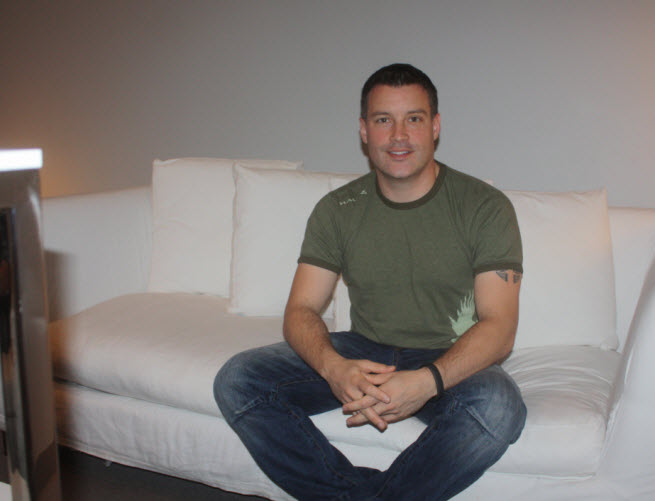Master Chief has been floating in space for a long time, since Halo 3 left us hanging more than five years ago. Bungie, the creator of the epic sci-fi video game series, has moved on to other stories and universes. But Microsoft has finally brought the Chief back, with his artificial intelligence sidekick Cortana, as part of Halo 4, the new video game for the Xbox 360. We get to find out what happens to the Chief and where 343 Industries, the Microsoft game studio that has inherited Halo, intends to take the $3 billion franchise for years to come. Josh Holmes, the franchise creative director at 343 Industries, is the man with the answers.
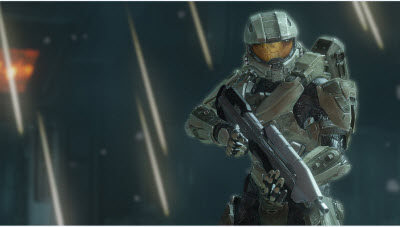 During the Chief’s hiatus, Microsoft has had a lot of time to plan what happens with the core of the story and the technology behind the game. Holmes sat down with us to explain just how the team at 343 Industries has completely re-imagined Halo. It has begun a brand new saga that, in contrast to the original Halo, has been envisioned as a three-part series from the very beginning. We’ve played the game and had plenty of questions for Holmes, who has to satisfy both veteran fans and new mainstream players at the same time. The questions on everybody’s lips: Did 343 fill the shoes of Bungie, and is Halo 4 worthy of the time and attention that fans are going to put into it?
During the Chief’s hiatus, Microsoft has had a lot of time to plan what happens with the core of the story and the technology behind the game. Holmes sat down with us to explain just how the team at 343 Industries has completely re-imagined Halo. It has begun a brand new saga that, in contrast to the original Halo, has been envisioned as a three-part series from the very beginning. We’ve played the game and had plenty of questions for Holmes, who has to satisfy both veteran fans and new mainstream players at the same time. The questions on everybody’s lips: Did 343 fill the shoes of Bungie, and is Halo 4 worthy of the time and attention that fans are going to put into it?
Here’s our edited interview with Holmes.
GamesBeat: You’re franchise creative director on Halo 4. Tell us more about some of the responsibilities you have here and what you oversee.
Josh Holmes: As franchise creative director, I oversee the interactive experiences we create within the Halo universe. I partner closely with Frank O’Connor, who’s the franchise development director. He oversees the story canon for the universe and plotting out the storylines. We partner together on that. I’m also the hands-on creative director for Halo 4.
GamesBeat: You got to sort of restart this and envision another series here, a whole new saga. What kind of opportunity was that? How did you approach that?
Holmes: It’s a huge opportunity, to take on the Halo universe. We don’t really think of it as “resetting” or “restarting.” It’s a new team and a new vision, but it’s a continuation of the saga that started with the first trilogy. We deliberately chose to connect the story and continue Chief’s story from the end of Halo 3, the Legendary ending.
 GamesBeat: Are there certain assumptions that fans can make about this series? That it’s a continuation of Master Chief and Cortana’s story?
GamesBeat: Are there certain assumptions that fans can make about this series? That it’s a continuation of Master Chief and Cortana’s story?
Holmes: Yeah … a lot of threads were left dangling at the end of Halo 3. Questions left to be answered. We’ve tried to take on a lot of those and connect to those threads. We’ve done a lot of work in the larger universe, building across the novels and working with Greg Bear on the “long, long ago” history of the Forerunners. We’ve planted a lot of seeds that pay off in Halo 4. We’re also working with Karen Traviss on the more contemporary fiction to span the time between Halo 3 and Halo 4. There’s a lot of story to tell there, and a lot of connections between what has come before and where we’re taking things in the future.
GamesBeat: So you have to balance what fans expect and are familiar with and want to see again and providing them with something new.
Holmes: Yeah. There’s obviously a lot of passion for the Halo universe. That comes from fans who’ve spent time playing the games and reading the books. There’s a lot of investment and we want to stay true to that. Speaking as a Halo fan myself, there’s a feel to playing Halo that is unlike any other shooter. As soon as you pick up the controller, it feels like Halo. Some of the elements of that are the way that the game responds dynamically to whatever you do, with AI that adapts and responds to your tactics on the battlefield. That’s something we wanted to preserve, and at the same time bring a new flavor to the party, adding a whole new enemy class in the Prometheans that changes up the experience. You get this blend of what’s familiar in Halo, the established universe and canon, and then some new places and new challenges.
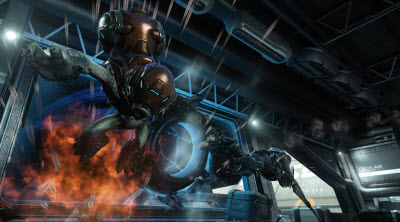 GamesBeat: How would you describe the Prometheans? Which guys are these?
GamesBeat: How would you describe the Prometheans? Which guys are these?
Holmes: The Prometheans are our new enemy class. They’re Forerunner in nature. They’re AI constructs within technological battle skins. They’re one of the primary threats that the Chief deals with through his ordeal here. As soon as you get to level three, that’s when you first face the Prometheans.
GamesBeat: What I noticed so far is a lot of subtle differences. You seem to have redone things a bit. I don’t remember there being orange gas cans on the back of the Warthogs.
Holmes: Yeah. We have a whole new team that’s been assembled at 343 to take on Halo 4 and the Halo universe. They bring their own perspective and vision to it. We have an amazing art director in Kenneth Scott. He’s brought his visual aesthetic to the universe. It’s a combination of what’s come before — because obviously there’s a lot of stakes in the ground that we want to preserve — but definitely there are changes that have come about as a result of the new team taking things on.
GamesBeat: The Elites seem to move a little faster.
Holmes: Maybe a little bit? The whole game is a bit faster. Some of that was trying to get back to the athleticism of playing the Chief and what it would be like to be a Spartan. He’s much more fluid and athletic in the way that he can move through the world. The enemies are faster as well to compensate for that.
GamesBeat: At a walk, he seems to move slower, and so you have to hold down the left stick to make him run faster?
Holmes: There’s definitely a sprint mechanic. He shouldn’t move slower at a walking speed. That might just be a matter of the environments being so large in scale. It’s a lot of space to traverse. We wanted to get back to that epic scale.
GamesBeat: Are the levels actually larger?
Holmes: Yeah, the physical space is larger for the levels. We have the largest physical spaces ever to ship in a Halo game.
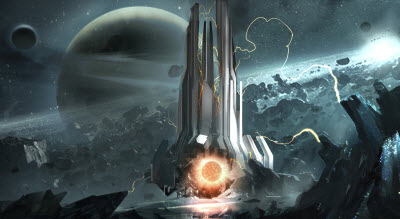 GamesBeat: I guess they can squeeze more out of the 360 these days? And that delivers something more for the creative side to work with.
GamesBeat: I guess they can squeeze more out of the 360 these days? And that delivers something more for the creative side to work with.
Holmes: Yeah. The results that you see in the game are a partnership between art and technology. You have some amazing developers and engineers on the team who have worked on this platform for years now. They’ve gotten to know, intimately, how to get the most out of the 360. They’ve made a lot of advancements in the technology that powers the engine and the experience. That enables the artistic vision that we have within the art team.
GamesBeat: What are some other changes that are noteworthy? The weapons, probably, have been tinkered with as well.
Holmes: Just from a basic level, what we’ve tried to do is bring a commitment to great storytelling to the game. We’ve taken a more character-oriented approach to the storytelling. We’ve tried to be a bit more intimate with Chief and delve more into his relationship with Cortana. We want to bring that to the surface in the way that we tell the story, with more immersive first-person storytelling and more connection to the environment around him. We’ve introduced a whole new world to explore in Requiem. You have new environments and a new threat that comes with that, the Prometheans. As a result of introducing that new enemy, then you have new weapons and abilities that brings to the table. You have a whole host of new Promethean weapons. You have new Promethean abilities. The universe has moved on four years, so there have been advancements within the USNC and Covenant, so you have new weapons and vehicles that are part of the package that come with those advancements. A lot of changes, a lot of additions across the entire experience.
GamesBeat: I don’t know if it’s my imagination, but does Cortana look different?
Holmes: Definitely. There’s obviously some enhancement in terms of visual fidelity in the game. We rebuilt all of the characters from scratch to deliver better character performances. You have a different art direction and visual aesthetic that’s been laid over the entire experience. You have subtle changes to the Master Chief, to the Covenant, to Cortana, across the board.
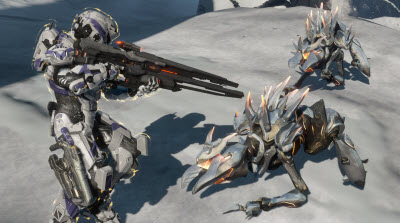 GamesBeat: That makes sense, given that she’s a more important part of the story.
GamesBeat: That makes sense, given that she’s a more important part of the story.
Holmes: She’s definitely an important part of the story. We have the Chief right at the center of it, but in a lot of ways Cortana is the more human side of the Chief. She’s that companion he’s able to bounce things off of. She reflects things back to you as the player, so she plays a pretty important role in the experience.
In addition to that, within this game, there’s a sort of secondary element to the story, which is her impending rampancy. As a smart AI, she has a lifespan of seven years, after which she starts to break down. At the beginning of the story she’s eight years old. You have this looming threat of her rampancy and how quickly that rampancy may accelerate while she and the Chief are dealing with all these external problems with galactic stakes and massive threats.
GamesBeat: It seems like you took to heart the notion that the story between Master Chief and Cortana is the one that most holds people’s interest.
Holmes: Yeah. There’s a lot of richness to the Halo universe and the story that’s been laid so far, but the Chief and Cortana were an element that we really wanted to explore. There was a lot of curiosity and fascination on our part with their relationship and the dynamic that would come about as a result of the challenges that were put upon them, the situation that they’re being pushed into. That was something we wanted to explore within the campaign.
GamesBeat: It makes it seem a lot different from other space-marine stories, too.
Holmes: [chuckles] It’s always a challenge, because you have this incredible action spectacle and space opera that’s going on, and then set against that backdrop we have this quieter, more personal story between the Chief and Cortana. The challenge is finding the balance between the two — finding the quiet moments within the action — so that we can bring that story into the foreground.
GamesBeat: What are some hints that you would throw in the direction of fans here anticipating this launch? What should they look forward to? What’s going to be answered for them? They have a lot of questions about the ending of the last game. How quickly are you answering some of those?
Holmes: Many fans, ourselves included, were left wondering what happens to the Chief at the end of Halo 3. That was the question that started us on our own creative journey, and that’s something that will definitely be answered. The story that is told within Halo 4 forces the Chief to change in pretty important ways. Fans can expect to see the Chief in a new light and see him forced to adapt based on the challenges that face him.
The other thing that’s a big change with this Halo is that we have the story of our campaign, and that’s the Chief’s story. It’s an important story. But there’s also a story that continues within our multiplayer experience. For the first time, we’ve connected multiplayer and campaign through storytelling. We have a new mode of play that picks up where the story of the campaign ends and then continues approximately six months after the end of the campaign. That becomes an episodic story told over the course of many weeks, Spartan Ops. You can play it by yourself, but it’s really fun if you’re playing with up to four players.
Each week, there’s a new episode in the series that follows a group of Spartans on board the Infinity. It sets up the story that’s taking place and shows you life on board that ship. Then you and your friends can jump in and play five missions that go live each week. Over the course of a 10-week season, you’ve got 50 new missions coming out along with 10 episodes, all of which are driving that story of the universe forward and continuing where campaign left off.
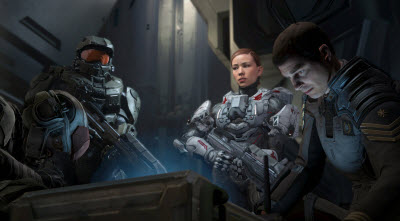 GamesBeat: This is free DLC, right?
GamesBeat: This is free DLC, right?
Holmes: All of that content, all the Spartan Ops content, is included with Halo 4. You have that whole season of play that you can engage in. All you need is an Xbox Live Gold membership so that you can get the content.
GamesBeat: It seems consistent with the trend we’ve seen in other blockbusters, where publishers want to keep players engaged for a longer time. Maybe for half a year or more. We’ve seen that with Call of Duty Elite, the maps coming out every month for those guys. It seems like it’s an increasingly important thing to hang on to your player beyond that first 10 hours.
Holmes: We see it as having a couple of real advantages. One is that in Halo, you have these two distinct audiences. You have the players who love playing campaign — they love the story and the universe — but maybe they’re a little bit too intimidated to jump in online and mix it up in multiplayer because the competition is too much or they just don’t necessarily have the skills to thrive. Then you have this other group that’s very much focused on the competitive multiplayer side, but maybe don’t have the exposure to as much of the story and the universe.
Spartan Ops becomes that intersection point where we can get players from both groups to get online and play together, knowing that everything that they’re doing is going towards their Spartan career and unlocking things through the progression system that they can use in both War Games competitive play and Spartan Ops. That, I think, is a really important thing, and it’ll hopefully teach a lot of those players who are more campaign-focused the skills that they need to be successful in multiplayer.
The other part is, as you say: Keeping players engaged is really important. If for no other reason than because having a vibrant community improves the experience for everybody. Then you’ve always got great matches when you go online. You’re never too long getting into a game. For us, that’s really important, to keep our community engaged and keep people playing Halo as much as possible.
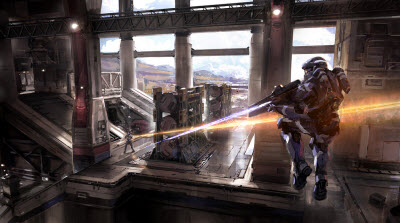 GamesBeat: If you can take them through maybe six months or so, that’s a good thing. Is there something that you would start doing after that point? Something like your standard DLC that people could purchase and download?
GamesBeat: If you can take them through maybe six months or so, that’s a good thing. Is there something that you would start doing after that point? Something like your standard DLC that people could purchase and download?
Holmes: We do have DLC offerings that come out in the form of War Games map packs. For competitive players who want additional maps to play on, we’ve announced three map packs, each containing three maps. We’ll bring those out within the first six months, possibly the first four months. We’ll be continuing to maintain the community and the playlists and introduce new game types and game modes based on the feedback that we get from the community.
For any shooter to be successful in this day and age, you need to respect the community and support the community as much as possible. That’s something that has been right at the core of the success of Halo. That’s why tools like Forge are so important to us. They allow that hardcore group of people within the community that want to create new maps and new modes, and then those people share that content with the rest of the community. It keeps it vibrant and keeps people playing.
GamesBeat: With the Cortana/Master Chief thing again: Sometimes you can go in a direction of more comic interaction between them or more dramatic. Is there a general direction you guys took with this?
Holmes: I wouldn’t say this is a darker game, in general, but it has some more personal themes that are in play. It depends on the situation. Cortana always has her personality where she inserts a little banter here and there with the Chief, and they’re really familiar with one another, having been through so much. They’re going to have that ease with one another, even when they’re dealing with extreme situations. But there are some more personal things that they’re dealing with, specifically around her rampancy, where it’s dealt with in a more serious way.
GamesBeat: I guess it’s nice to have banter in what could be a relentlessly downbeat sort of story. [laughter]
Holmes: Yeah. In the midst of all the action and all the high stakes, it’s nice to have Cortana there to bring in a little levity.
VentureBeat's mission is to be a digital town square for technical decision-makers to gain knowledge about transformative enterprise technology and transact. Learn More
